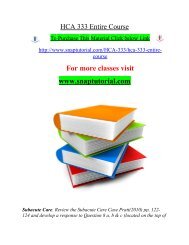HCA 375 Week 5 Assignment Research Paper (Value-Based Purchasing)/snaptutorial
- No tags were found...
You also want an ePaper? Increase the reach of your titles
YUMPU automatically turns print PDFs into web optimized ePapers that Google loves.
<strong>HCA</strong> <strong>375</strong> <strong>Week</strong> 5 <strong>Assignment</strong> <strong>Research</strong> <strong>Paper</strong><br />
(<strong>Value</strong>-<strong>Based</strong> <strong>Purchasing</strong>)<br />
To Purchase This Material Click below Link<br />
http://www.<strong>snaptutorial</strong>.com/<strong>HCA</strong>-<strong>375</strong>/<strong>HCA</strong>-<strong>375</strong>-<strong>Week</strong>-5-<br />
<strong>Assignment</strong>-<strong>Research</strong>-<strong>Paper</strong>-(<strong>Value</strong>-<strong>Based</strong>-<strong>Purchasing</strong>)<br />
For more classes visit<br />
www.<strong>snaptutorial</strong>.com
<strong>HCA</strong> <strong>375</strong> <strong>Week</strong> 5 <strong>Assignment</strong> <strong>Research</strong> <strong>Paper</strong><br />
<strong>Value</strong>-<strong>Based</strong> <strong>Purchasing</strong><br />
The Center for Medicare and Medicaid Services C.M.S. began phasing<br />
in its value-based purchasing program in 2007. <strong>Value</strong> based purchasing<br />
links payment directly to the quality of care provided. It is one strategy<br />
being used by C.M.S. to transform the current payment system by<br />
rewarding providers for delivering high quality, efficient clinical care.<br />
There are three aspects to the program: patient experience, hospitalacquired<br />
conditions and achievement of expected treatment for specific<br />
clinical diagnoses.<br />
Select one of the following hospital-acquired conditions:<br />
1. Surgical site infection<br />
2. Pressure Ulcers<br />
3. Catheter-associated urinary tract infections<br />
4. Harm related to falls<br />
For your Final <strong>Paper</strong>:<br />
1. Include a brief discussion of the chosen hospital-acquired condition<br />
and why it is considered preventable.<br />
2. Explain the legal implications related to a patient developing the<br />
condition and the role that disclosure plays.<br />
3. Describe accreditation expectations related to this condition.<br />
4. Analyze the outcomes of continuous quality monitoring consider cost<br />
as it relates to quality.
The following questions and/or topics should be utilized in the<br />
development of your Final <strong>Paper</strong>:<br />
Hospital acquired conditions:<br />
1. What is meant by the term “hospital acquired condition”?<br />
2. Is the condition you selected always preventable? Why or why not?<br />
3. How does reducing or preventing this condition indicate quality<br />
healthcare practices?<br />
Legal implications:<br />
1. What role does communication between the healthcare team and the<br />
patient/family play in preventing this condition?<br />
2. Why might a healthcare provider be reluctant to discuss the<br />
development of this condition with the patient and family?<br />
3. What are the potential ramifications of not discussing the<br />
development of this condition with the patient and family?<br />
4. How might members of the healthcare team present this information<br />
to the patient and family?<br />
5. What, if any, is the link between disclosure and litigation?<br />
Accreditation expectations:<br />
1. The Joint Commission accredits 82% of the hospitals in the United<br />
States. Sollecito & Johnson, 2013, p. 516.<br />
2. What expectations does the Joint Commission have with regards to<br />
the condition you selected?<br />
3. How is it assessed by surveyors during an accreditation survey?
Outcomes related to cost and quality:<br />
1. What continuous quality improvement strategies might you use to<br />
involve members of the healthcare team in planning and implementing<br />
improvements related to this issue?<br />
2. Provide examples for each of the following performance<br />
improvement levels: localized improvement, organizational learning,<br />
process reengineering, and evidence-based medicine. Refer to page 5 in<br />
your text if needed.<br />
3. What role does education, research, collaboration, information<br />
technology, leadership, and teamwork play in addressing this issue?<br />
4. Of the strategies listed which one do you believe would generate the<br />
best outcomes and cost the least to implement? Explain your opinion.<br />
The Final <strong>Paper</strong> must be eight-to ten-pages excluding title and<br />
references pages and should demonstrate understanding of the reading<br />
assignments, class discussions, your own research and the application of<br />
new knowledge. Your paper must use a minimum of six scholarly, peerreviewed<br />
sources from the Ashford University Library that were<br />
published within the past five years and that are referenced according to<br />
APA guidelines as outlined in the Ashford Writing Center.<br />
Writing the Final <strong>Paper</strong><br />
The Final <strong>Paper</strong>:<br />
1. Must be eight to ten double-spaced pages in length excluding title<br />
and reference pages, and formatted according to APA style as outlined<br />
in the Ashford Writing Center.<br />
2. Must include a title page with the following:<br />
a. Title of paper<br />
b. Student’s name
c. Course name and number<br />
d. Instructor’s name<br />
e. Date submitted<br />
3. Must begin with an introductory paragraph that has a succinct thesis<br />
statement.<br />
4. Must address the topic of the paper with critical thought.<br />
5. Must end with a conclusion that reaffirms your thesis.<br />
6. Must use at least six scholarly, peer-reviewed sources that were<br />
published within the past five years from the Ashford University Library.<br />
7. Must document all sources in APA style, as outlined in the Ashford<br />
Writing Center.<br />
8. Must include a separate reference page, formatted according to APA<br />
style as outlined in the Ashford Writing Center.<br />
Carefully review the Grading Rubric for the criteria that will be used to<br />
evaluate your assignment.
















